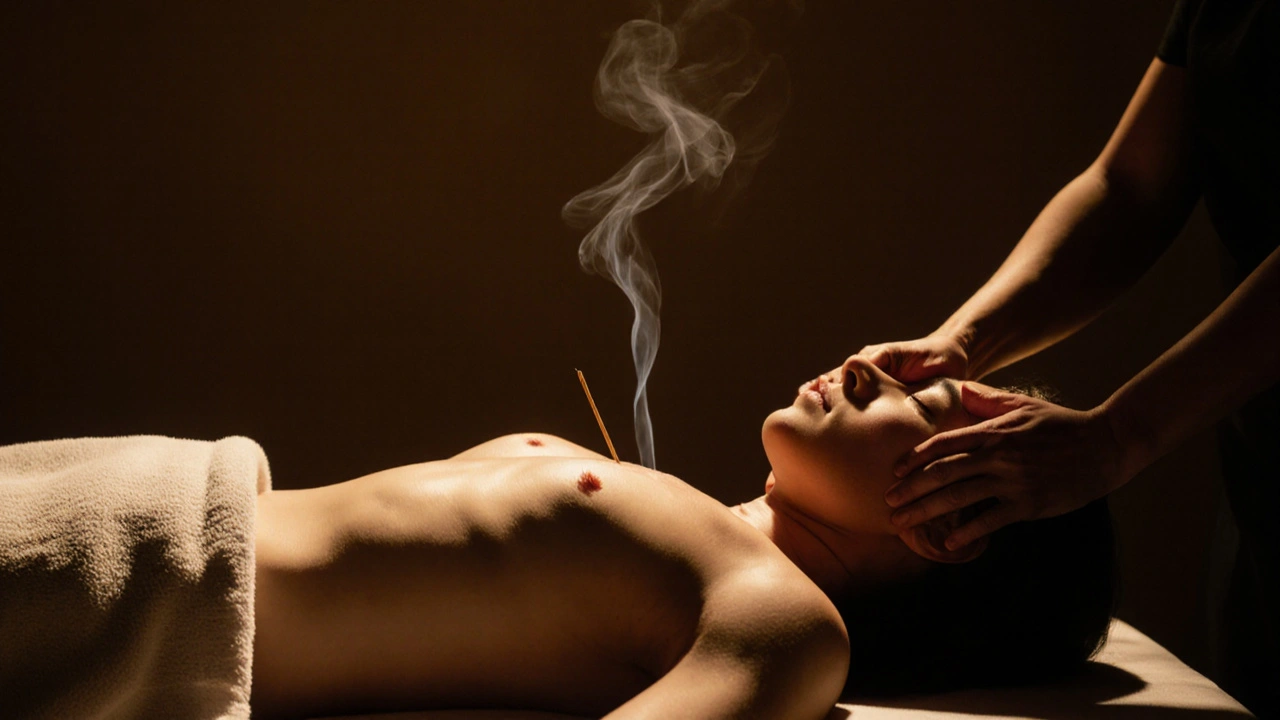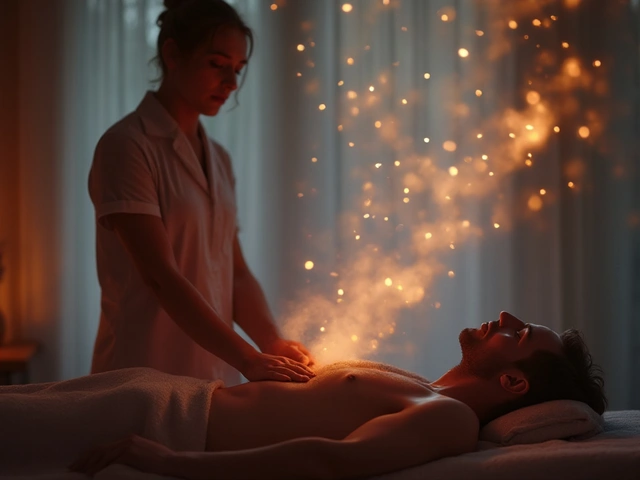Tantric Massage Readiness Assessment
How ready are you for tantric massage?
Answer these 5 questions honestly to understand if this practice aligns with your current needs and goals.
Answer all questions to see your results.
Most people think tantric massage is about sex. It’s not. If you’ve ever walked into a spa and seen a sign that says "tantric massage" with soft lighting and suggestive images, you’ve been sold a myth. The real thing has nothing to do with arousal or climax. It’s about tantric massage as a tool to reconnect with your body, release stored tension, and awaken a quiet, deep energy that’s been buried under years of stress, numbness, or self-judgment.
What Tantric Massage Really Is (And What It Isn’t)
The word "tantra" comes from ancient Indian texts meaning "weave" or "loom"-a metaphor for how everything in life is connected. Traditional tantra is a spiritual system that blends meditation, breathwork, ritual, and energy work to awaken the life force within you. Modern tantric massage borrows from this, but it’s not the same. It’s been simplified, stripped of rituals, and repackaged for busy people who don’t have time for months of spiritual practice. In places like Prague, practitioners now call it "whole-body sensory massage" to avoid the sexual connotations. That’s because most people who book it are looking for relief-not eroticism. They’re tired. They feel disconnected from their bodies. They’ve been told to push through pain, ignore emotions, and stay productive. Tantric massage doesn’t fix that with a quick fix. It invites you to sit with what’s there. A real tantric massage session is slow. It’s quiet. The touch is warm, deliberate, and non-goal-oriented. There’s no expectation of orgasm. No pressure to perform. Instead, the goal is to let energy move through your body-not to chase pleasure, but to feel what’s already moving beneath the surface. This is where healing begins.Why It Works for Personal Growth
Think about how often you ignore your body. You sit at a desk for hours. You scroll through your phone before bed. You tense your shoulders when you’re anxious. You hold your breath when you’re scared. Over time, your body learns to shut down. Numbness becomes normal. Tantric massage interrupts that pattern. With gentle, sustained touch-often on areas people avoid, like the belly, inner thighs, or back-it helps release old emotional holding patterns. This isn’t psychology. It’s physiology. Trauma, shame, and stress don’t just live in your mind. They live in your muscles, your nerves, your skin. People who’ve done this regularly report things like:- Feeling more present in daily life
- Less anxiety around touch or intimacy
- Better sleep without needing sleep aids
- More comfort in their own skin
- Deeper connections with partners-not because of sex, but because they finally feel like themselves
Your 4-Step Personal Development Plan
This isn’t a one-time spa treat. To make tantric massage part of your growth, you need structure. Here’s how to build it into your life.Step 1: Clarify Your Intention
Before you book anything, ask yourself: Why am I doing this? - Do you want to release stress? - Are you trying to heal from past trauma? - Do you feel disconnected from your body? - Are you curious about energy work? Your intention guides the session. A good practitioner will ask you this before you even undress. If they don’t, walk away. This isn’t a massage-it’s a co-created experience.Step 2: Choose the Right Practitioner
Not all "tantric" therapists are equal. In the Czech Republic, only about 30% of centers offer authentic work. The rest are marketing gimmicks. Here’s how to spot the real ones:- They offer a pre-session consultation (at least 20-30 minutes)
- They explain the process clearly-no vague promises
- They don’t use words like "orgasmic," "sensual," or "erotic" in their descriptions
- They have training in somatic therapy, breathwork, or trauma-informed touch
- They’re part of a professional group like the Association of Whole-Body Sensory Therapists
Step 3: Prepare for the Session
On the day:- Don’t eat a heavy meal two hours before
- Turn off your phone
- Wear comfortable clothes to the session
- Bring a notebook if you want to write afterward
- Arrive 10 minutes early to settle in
Step 4: Integrate the Experience
This is where most people fail. They have a powerful session, then go right back to their old habits. Integration is the key. After your session:- Drink water
- Take a quiet walk
- Write down what came up-emotions, memories, sensations
- Avoid screens for at least an hour
- Set aside 5-10 minutes daily to sit quietly and breathe into your body

What to Expect After a Few Sessions
After one session, you might feel deeply relaxed. After three, you might notice changes in how you respond to stress. After six to eight, many people report: - Less reactivity in relationships - More patience with themselves - A quiet sense of inner calm that doesn’t depend on external events - A deeper trust in their own body’s wisdom This isn’t magic. It’s somatic education. You’re relearning how to feel. And that takes time.Common Misconceptions
Let’s clear up the noise:- Myth: Tantric massage leads to sex. Truth: It’s not sexual. It works with sexual energy-but not to produce arousal.
- Myth: You have to be spiritual to benefit. Truth: You just have to be willing to feel.
- Myth: It’s only for couples. Truth: Most clients are solo. This is about your relationship with yourself.
- Myth: It’s expensive and inaccessible. Truth: Prices range from $80-$150 AUD. It’s less than a weekend getaway.

Who This Is For (And Who It Isn’t)
This practice is ideal for:- People who feel emotionally numb
- Those recovering from trauma or chronic stress
- Anyone who hates their body or avoids touch
- People seeking deeper self-awareness without therapy
- Those looking for a quick sexual thrill
- People who aren’t ready to feel uncomfortable emotions
- Anyone pressured by a partner to try it
Where to Go Next
If you’re curious, start small. Find one certified practitioner in your area. Book a single session. Don’t go in with expectations. Just show up. Let your body speak. This isn’t about becoming someone else. It’s about remembering who you already are-beneath the noise, the shame, the busyness. The body remembers what the mind forgets. Tantric massage is just a quiet way to listen.Is tantric massage the same as erotic massage?
No. Erotic massage is designed to stimulate sexual arousal and often ends in orgasm. Tantric massage is about awakening energy, releasing emotional tension, and reconnecting with your body-not sexual release. While both may use touch, the intention, technique, and outcome are completely different.
Do I need to be naked during a tantric massage?
You’ll be covered with towels at all times, except for the area being worked on. Most people choose to be fully unclothed for comfort and to allow energy to flow freely, but you can keep underwear on if that feels safer. A good practitioner will never pressure you. Your boundaries are sacred.
Can I do this at home by myself?
You can practice body awareness and gentle self-touch, but true tantric massage requires a trained practitioner. The depth of touch, energy awareness, and non-judgmental presence you receive from someone else is hard to replicate alone. Think of it like therapy-you can journal on your own, but real healing often needs a guide.
How many sessions do I need to see results?
Some people feel shifts after one session-usually deep relaxation. Lasting change-like reduced anxiety, better body image, or emotional release-usually takes 3 to 6 sessions spaced 2-4 weeks apart. Like fitness, consistency matters more than intensity.
Is tantric massage safe for trauma survivors?
Yes-if you choose a practitioner trained in trauma-informed care. Look for someone who understands nervous system regulation and gives you full control over touch. Avoid anyone who pushes you to "let go" or "open up." Real safety means you’re always in charge.






